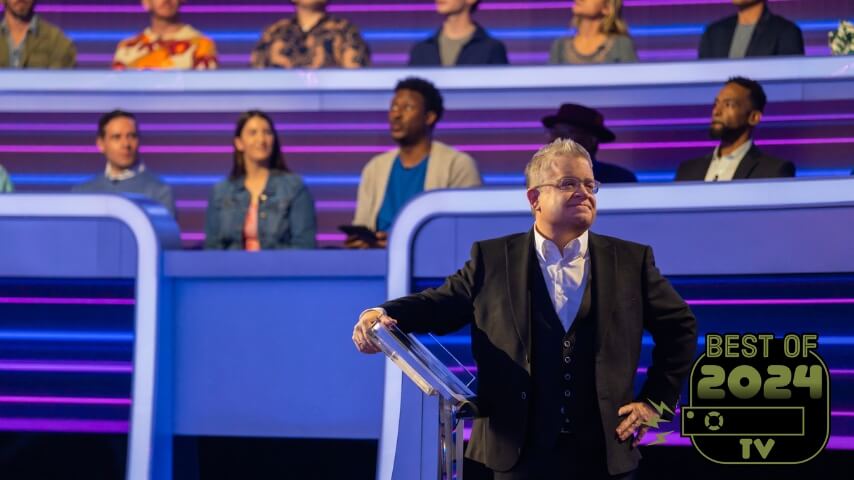In 2024, primetime game shows became about the actual games again
The Floor, The 1% Club, and other series brought clever gameplay and challenging questions back to TV.
The 1% Club (Photo: Adam Rose/Prime)
Between 1945 and 1964, first on radio and then on two different TV networks, one of the most popular game shows in America was Queen For A Day— although calling it a “game show” has always been a bit of a stretch. The contestants didn’t really have to do anything to win, except to tell their sad stories of pain, poverty, and loss. Whichever tale of woe most moved the audience triggered a victory, resulting in a pile of prizes and, presumably, copious happy tears. Queen For A Day has been revived a couple of times since the ’60s, without as much success. But the basic format of the show has never fully gone away.
For much of the 21st century, most network TV game shows (all of which these days air in primetime) have fallen into one of two categories. Some are celebrity-laden revivals of the classic daytime shows of the ’60s, ‘70s, and ‘80s: Password, Pyramid, Match Game, and the like. And the others take their cues from the emotionally manipulative early-2000s hit Deal Or No Deal, combining enormous sets, gimmicky concepts, and games that take so long to play that the viewers can learn every dramatic detail of the contestants’ complicated lives, making them easier to cheer on—and their failures all the more devastating. These shows are Queen For A Day in all but name.
But in 2024—for reasons unclear but not unwelcome—game shows started becoming more about the actual games again. The turnaround began in January, when Fox debuted The Floor. Superficially, from the commercials, the project looked like another set-forward affair, leaning heavy on its fancy lighting package and famous host, Rob Lowe. What became clearer once The Floor premiered was that the game itself was unexpectedly challenging and unlike anything else currently on TV.
In season one of The Floor, dozens of contestants were strewn across a nine-by-nine grid and tasked to compete in head-to-head contests, with the winner seizing the loser’s territory. In these “duels,” the contestants took turns identifying pictures in a particular category (like “Girl Groups” or “Nursery Rhymes”), going back and forth and getting penalized for misses, until one of them ran out of time and lost. Match by match, episode by episode, the contenders were winnowed down until just a few people were left on big chunks of lit-up floor. The last person standing took home $250,000.
The Floor has its flaws. The territory-seizing setup often rewards players who lay low and wait for a chance to make one big move. And while the “identify this picture” concept works well when contestants have to name a person or a movie, trouble often ensues when they’re naming, say, “things associated with the gym.”
Still, as the clock ticks down and the images get harder to identify, the pressure mounts. The duels are dramatic and fast-paced, and each episode features about eight or nine of them. Because there are so many duels per hour, the “getting to know the contestants” chit-chat is kept to a minimum. As far as viewers know, nothing is really riding on this game except the pleasure of playing and the opportunity to win a chunk of money that’s sizable but not a “quit your job, set for life, setting up a charitable foundation” windfall.
The instant popularity of The Floor (which just finished airing its second season earlier this month) set the tone for 2024. Over the summer, Prime Video (and Fox, for broadcast) debuted an American version of the British series The 1% Club, hosted by Patton Oswalt. The 1% Club is another “winnowing down” game, with a big pool of contestants who are reduced to a handful over the course of a single episode via increasingly difficult brain-teasers that require basic thinking skills but not specialized knowledge. Again, while Oswalt banters with the players, none of them are on TV long enough to become “characters,” per se—and very few of them talk about doing anything life-changing with the maximum $100,000 prize.
Though it’s been (unofficially) cancelled by ABC after one season, the Shaquille O’Neal and Gina Rodriguez-hosted summer series Lucky 13 was, while it aired, another promising and original new game show. Contestants answered 13 true/false questions—some fairly easy, others requiring more guesswork—and then won money based on whether they could properly estimate the number of answers they got right. In the fall, The CW added new game shows based on the board games Trivial Pursuit and Scrabble, both of which reward contestants who are actually good at those games rather than people cast solely for being telegenic. In other words: Something seems to have shifted this year with American game shows, which may be trending toward becoming more intellectually engaging.

 Keep scrolling for more great stories from The A.V. Club.
Keep scrolling for more great stories from The A.V. Club.